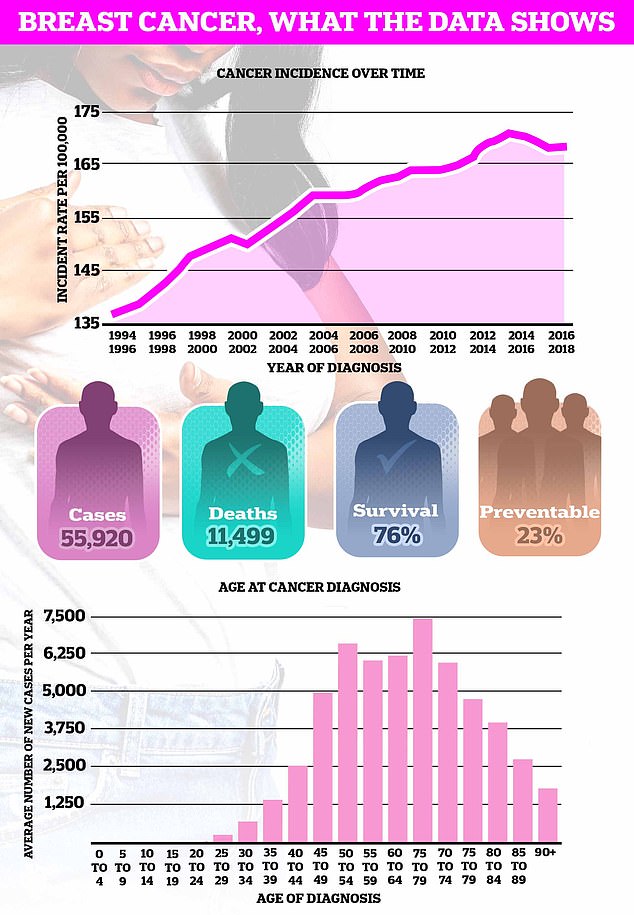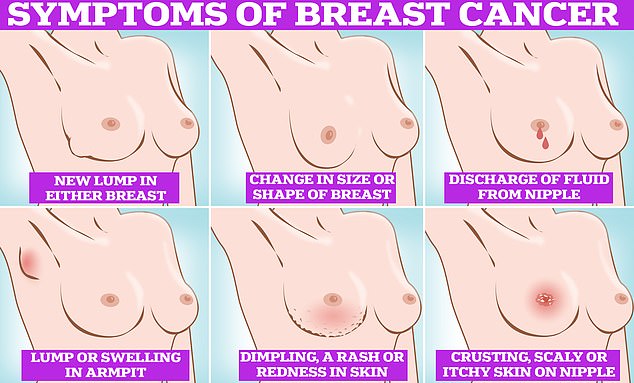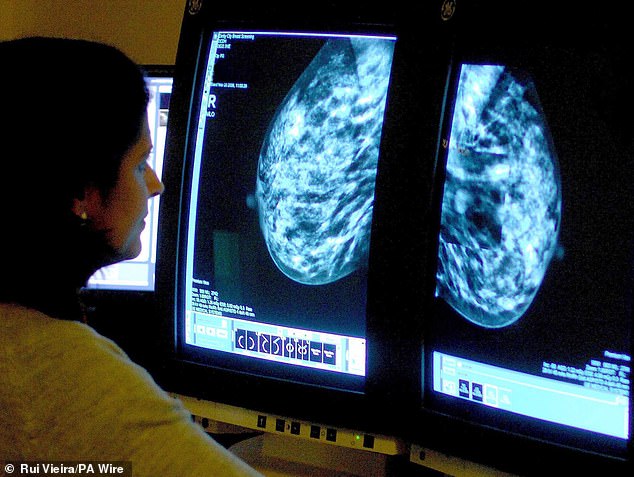Scientists have warned that women carrying a lot of excess fat are a third more likely develop breast cancer compared to their slimmer counterparts
Researchers analysed health data from 168,547 postmenopausal women and found a link between being overweight and developing the disease.
And the likelihood was even higher for women who have a diagnosis of heart disease.
Researchers found that for every 5kg/m2 increase in body mass index (BMI), women with heart disease had a 31 per cent higher risk of being diagnosed with breast cancer.
Meanwhile, for the same increase in BMI, women without heart disease had a 13 per cent higher risk of developing breast cancer.
BMI—body mass index— is calculated by dividing a person’s weight by their height, and is used around the world to benchmark if someone is underweight, of a ‘normal’ healthy weight, overweight, or obese.
The combination of being overweight and having heart disease was estimated to lead to 153 more cases of breast cancer per 100,000 people each year than expected.
However, the development of type two diabetes was not found to be linked to a higher risk of breast cancer by the International Agency for Research on Cancer team.

Breast cancer is the UK’s most common cancer with almost 56,000 cases diagnosed per year
‘This study should also inspire future research to include women with a history of cardiovascular diseases in weight loss trials for breast cancer prevention.’
The study suggests that shedding the pounds could lower women’s risk of breast cancer.
Lead author of the study, Dr Heinz Freisling, who works in the specialised cancer agency of the World Health Organization, said: ‘The findings of this study could be used to inform risk-stratified breast cancer screening programs.
The findings have been published by Wiley online and in CANCER, a peer-reviewed journal of the American Cancer Society.
Some studies suggest that fat tissue produces excess amounts of the hormone oestrogen, which in high levels has been linked to breast cancer.
Earlier this year Danish researchers revealed being obese makes breast cancer survivors up to 80 per cent more likely to die of the disease.
Weight-related health problems, like high blood pressure and high blood sugars, as well as excess body fat also raised the risk of the disease returning, by 70 per cent.
The scientists theorised that this combination—medically known as metabolic syndrome—triggers inflammation in the body, which prevents the immune system from effectively fighting cancer cells.

Symptoms of breast cancer to look out for include lumps and swellings, dimpling of the skin, changes in colour, discharge and a rash or crusting around the nipple
But alarming research has suggested breast cancer cases globally are rising in under-50s—an alarming phenomenon that has baffled experts.
It comes amid an alarming prediction earlier this year that breast cancer deaths in the UK will soar by more than 40 per cent by 2050.
By the same year, globally, another study estimated there will be 3.2million new cases and 1.1million breast-related deaths per year if current trends continue.
The disease is far more prevalent in those over 50, which is the age women typically experience the menopause.
It is the most common type of cancer in the UK, taking the lives of around 11,500 Britons and 42,000 Americans each year.
Early signs of the disease are a lump in the breast, swelling or lump in the armpit, change in size or shape of breasts, discharge of fluid from the nipple.
Others include dimpling, a rash or redness on skin, as well as crusting, scaly or itchy skin on the nipple.
Despite years of pleas from cancer charities, more than a third of women in the UK still do not regularly assess their breasts.

A third of women still do not regularly check their breasts (file photo)
However, it should be part of your monthly routine, so you can notice any unusual changes, charity CoppaFeel previously said.
You can check in the shower, when you are lying down in bed or in the mirror before you get dressed.
Because breast tissue isn’t just found in your boobs, it’s also important that men and women check the tissue all the way to their collarbone and underneath their armpit.
There is no right or wrong way to check your breasts, as long as you know how your breasts usually look and feel, says the NHS.
But one of the most popular methods online involves using the pads of your fingers.
Examining your entire breast and armpit area, simply, rub and feel from top to bottom of the breast.
You should also feel in semi-circles and in a circular motion around your breast tissue to feel for any abnormalities, according to a guide shared in a blog post by the University of Nottingham.
Then look in the mirror for any visual lumps, skin texture and changes and changes in nipple shape or abnormal discharge.
If you spot any changes, you should get it checked out by your GP.
Women aged between 50 and 70 should also be attending routine breast cancer screening.












